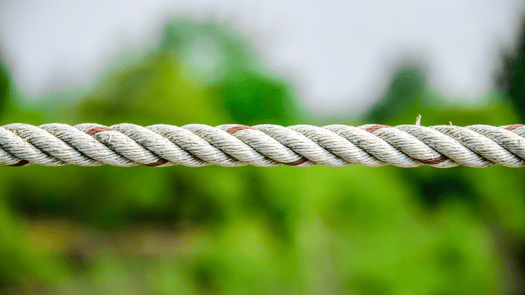
Increasing Your Capacity for Mental Complexity
Award-winning journalist Thomas Friedman in his book Thank You for Being Late: An Optimist's Guide to Thriving in the Age of Accelerations, helped popularize the hockey stick-shaped curve that demonstrates technological growth and change made possible by the ever-expanding capacity of microchips. The simple graphic below shows how, over time, the rate of technological change accelerated to the point where it is now beyond human ability to adapt fast enough to the change. This reality creates stress due to the complexity in many facets of lifes.
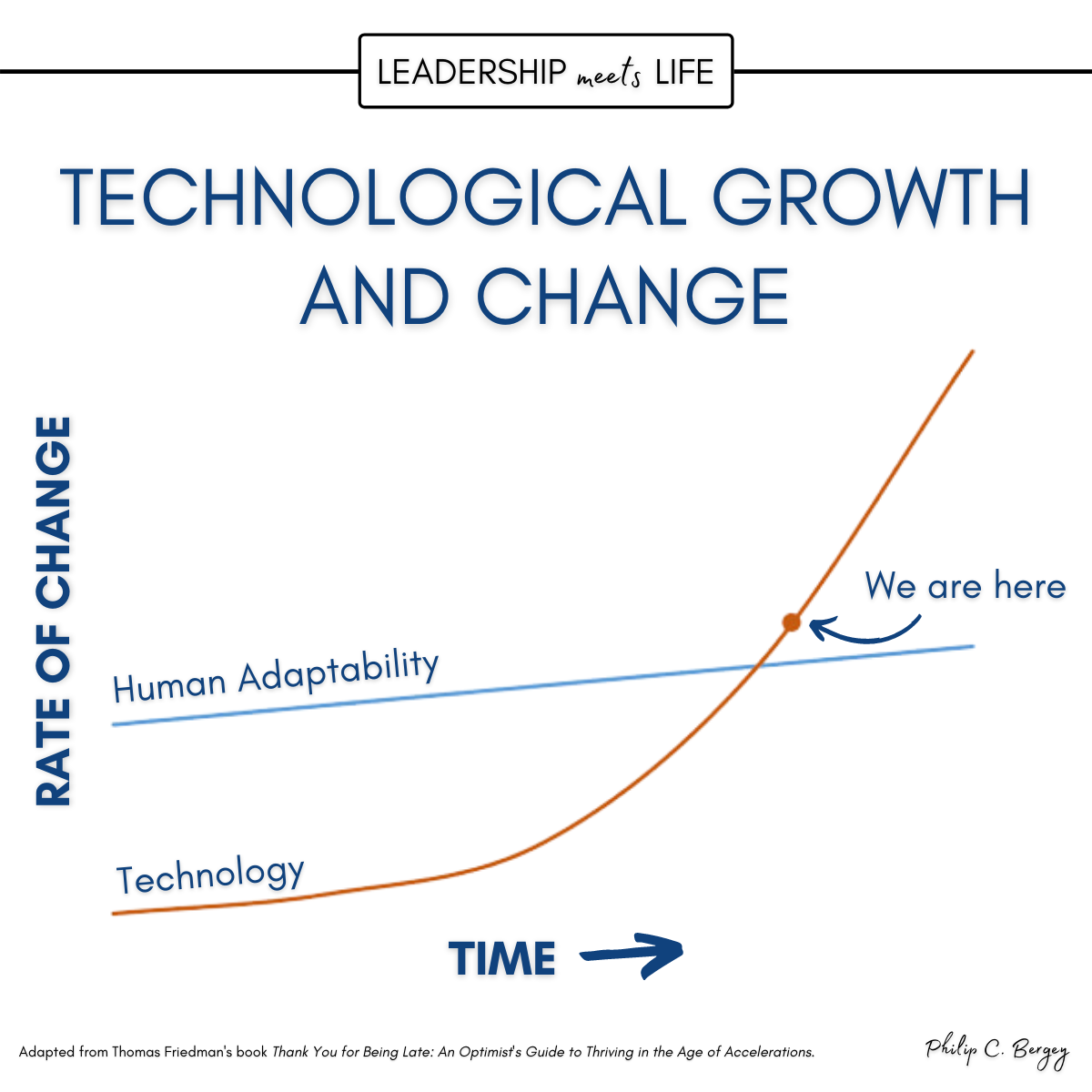
Mental Complexity
Researchers and authors Robert Kegan and Lisa Lahey have been working for decades to help people understand how to gain more perspective in life in order to make intended changes in life. My Leadership Meets Life Podcast episode earlier this month provides a quick primer on Kegan and Lahey’s work to address what they call Immunity to Change. This blog post builds on that podcast episode.
Kegan and Lahey note:
When we experience the world as “too complex” we are not just experiencing the complexity of the world. We are experiencing a mismatch between the world’s complexity and our own at this moment. There are only two logical ways to mend this mismatch—reduce the world’s complexity or increase our own [complexity].
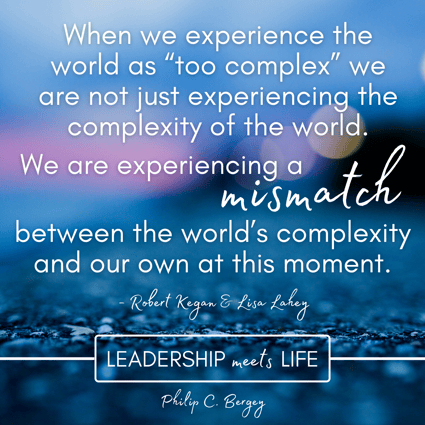
Increasing our mental complexity is not only a cognitive exercise but one that involves both head and heart in a messy expedition that includes the interplay of both thinking and feeling. Such messy work is only possible by addressing the adaptive work that lies behind our immunity to change.
Adaptive work—in which there is no immediately-known solution for a challenge we are facing, is in contrast with technical work—in which there is a known solution that simply requires the application of the fix. Addressing an adaptive challenge, as author Ronald Heifetz and his colleagues have shown in their work on adaptive leadership, involves a sustained effort in which the goal is learning before “fixing” can happen. Applying a technical fix to an adaptive challenge that we don’t understand only tends to make it even more difficult to resolve the challenge at hand.
Kegan and Lahey note that increasing our mental complexity can be done with the help of what they call optimal conflict, defined as:
- “The persistent experience of some frustration, dilemma, life puzzle, quandary, or personal problem that is...
- Perfectly designed to cause us to feel the limits of our current way of knowing…
- In some sphere of our living that we care about, with...
- Sufficient supports so that we are neither overwhelmed by the conflict nor able to escape or defuse it.
A Three-Strand Rope
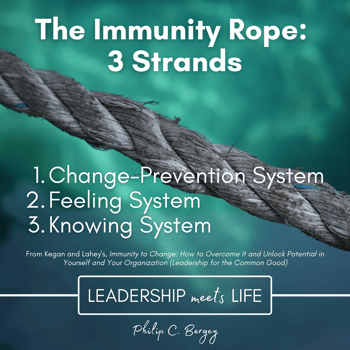
Kegan and Lahey use a three-strand rope analogy to illustrate why the immunity to change is so difficult to address. Built into our very being (and by extension, our organizations) are interacting systems that maintain stability—and thereby create an immunity to change, even intended change.
The first strand in the immunity rope is a change-prevention system (in a person or an organization) that thwarts the challenging aspirations for changes we would like to make.
The authors point to a study of heart patients in which only one in seven people with severe heart disease was able to make the necessary changes to their lifestyle despite all participants in the study saying they wanted to make the changes. 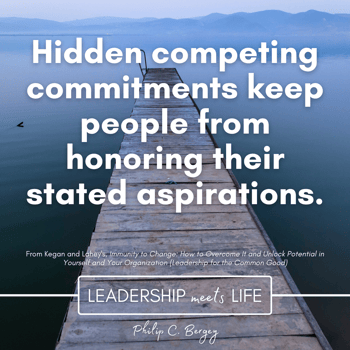 Hidden competing commitments, suggest Kegan and Lahey, keep people from honoring their stated aspirations.
Hidden competing commitments, suggest Kegan and Lahey, keep people from honoring their stated aspirations.
This internal change-prevention system exists alongside a second strand in the immunity to change rope, called a feeling system. The function of this feeling system is to help manage anxiety one feels about their insecurity that lies behind hidden assumptions, or as Kegan and Lahey call it, one’s own “brand of terror.”
The third strand in the immunity to change rope is called the knowing system; or if you prefer the $1000 term, one’s personal epistemology, which is how one keeps organizing their reality to maintain stability. This stability plays directly into one’s difficulty in making a particular change in life.
These three interwoven strands (systems) in the immunity to change rope—change-prevention, feeling, and knowing—serve to provide stability to function in life. However, this same stability that helps someone make sense of, and keep in check, their sense of being in the world, is directly related to one’s difficulty—that is, immunity—to making changes they say they want to make.
The table below shows Kegan and Lahey’s four-column tool they call an immunity x-ray that helps someone view their own immunity to change.
In brief, the immunity x-ray works like this:
- In Column 1: write one or more commitments you hold—improvement goals—for a change you want to see
- In Column 2: list things you are doing or not doing instead of the stated commitment or goal; that is, list behaviors that work against the stated goals
- In Column 3: name the likely hidden, competing commitments that keep you from accomplishing the commitments/goals you named in column 1
- In Column 4: list the Big Assumptions that hold you, that is, assumptions that you make that subtly and quietly undermine your progress by having you behave in the unhelpful ways you listed in Column 2
At the end of this blog post, you’ll find a blank template of the Kegan and Lahey model for you to take your own immunity x-ray.
It will take time, courage, vulnerability, and candor to honestly list the content for the four columns. You may want to enlist a thought partner who knows you well.
The immunity x-ray works for organizations too. Filling out the x-ray for your organization with key leaders could be an eye-opening and life-changing exercise.
From Subject to Object
At the root of the Kegan and Lahey immunity to change model is proper perspective. All of us—individual leaders and organizations—function in life by using mental models and assumptions. Life would be unmanageable without doing this.
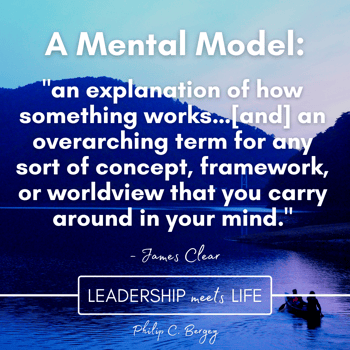 James Clear defines a mental model simply as: "an explanation of how something works…[and] an overarching term for any sort of concept, framework, or worldview that you carry around in your mind.”
James Clear defines a mental model simply as: "an explanation of how something works…[and] an overarching term for any sort of concept, framework, or worldview that you carry around in your mind.”
Supply and demand is a mental model that helps us understand an economic theory. You have a mental model of critters included in the notion of “dog,” and sometimes that model gets tested or expanded when you see a coyote or wolf.
But while assumptions we make, and mental models we hold, are efficient ways of making sense in the world, they are imperfect and often flawed. When we are challenged in life, it’s often a mental model that is being tested. And that’s exactly the point of the immunity x-ray: to challenge big assumptions, mental models we hold about ourselves or our organization, that often function in the background and may go years—or a lifetime—without being tested.
The challenge is being open enough and courageous enough in life to allow our mental models and assumptions to be tested. Our hidden assumptions, that is, mental models operating in the background of our mind, are assumed to be true. They may or may not actually be true, but when untested or operating blindly, they provide a reference point for us in making decisions all day long.
An invisible assumption about myself that I’m not aware of, is an assumption that has hold of me. It is the subject and I’m the object. However, if I’m open to critique by someone or if in using the immunity x-ray I’m willing to test an assumption about myself that I hunch is holding me back or creating an immunity to change, I can assess whether the mental model remains helpful or whether I wish to adjust it.
Think of times in your life when a mental model was tested. Perhaps you met someone of a particular socio-economic or racial-ethnic group who didn’t fit your assumptions or stereotypes. It began to allow you to realize first, that you held that assumption; and second, that your assumption no longer fits everyone you had in that neat model.
As you opened to further testing of the model, you realized that others don’t fit the model either. Ideally, this led you to adjust your model as the assumptions you were making no longer seemed “true.”
As long as the mental model was operating without scrutiny, it had a hold on you. However, when you changed the perspective and looked at it more critically, the model went from being a subject to an object. It no longer held you, but rather you held it.
The same is true of any idea or thought behind our eyeballs. When we can articulate something enough to assess it, as if we’re holding it in our hands, we can consciously and intentionally choose what we want the model to be. In that way, we now hold the very thing that held us. We have choices…more than we realize.
Mental Development
For decades Robert Kegan has been developing an adult development theory. Some of you may find it interesting in detail, but without boring those who just want the shorter version, the theory can be summarized like this:
A human body reaches a physical peak relatively early in its life. However, mental development, especially mental complexity, can keep growing. This explains in part why whether you view a group of people in their thirties or a group in their sixties, you will find a range of capacity for mental complexity that Kegan views as stages or plateaus.
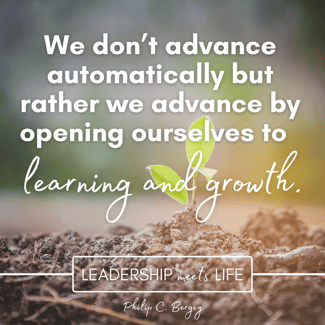 We don’t advance automatically but rather we advance by opening ourselves to learning and growth. Permitting ourselves times of optimal conflict mentioned earlier allows for a lifetime of growth and development.
We don’t advance automatically but rather we advance by opening ourselves to learning and growth. Permitting ourselves times of optimal conflict mentioned earlier allows for a lifetime of growth and development.
Kegan’s theory, and then in his collaboration with colleague Lisa Lahey, suggests three such complexity stages or levels:
- Socialized mind, characterized as those of us who are shaped by definitions of our personal environment and by our relationships and “schools of thought” to which we subscribe
- Self-authoring mind, characterized by those of us who can step back enough from our social environment to generate what Kegan and Lahey call “an internal ‘seat of judgment’” to evaluate and make choices about external/others’ expectations.
- Self-transforming mind, characterized by those of us who can step back from and reflect on the limits of our own ideology, can see how any system of thought is in some way incomplete, and who tend to be more comfortable with contradiction and opposites.
Kegan and Lahey’s stage theory makes sense to me in my own development. However, not everyone agrees with the concept of stage theories. Perhaps the reality is that at different times of the day or times of our lives we may move among the stages depending on circumstances, or the environment we’re in, or the particular people around us at the time. I’ve included the Kegan and Lahey complexity development concept as food for thought.

We live in an increasingly complex world, and we are living in times of significant complexity. Your relationships, your leadership, and the overall quality of your life depend on your capacity to evaluate fairly and be open to testing and adjusting your assumptions and mental models. Ultimately, assumptions that “hold us” limit our effectiveness, health, and wellbeing.
Consider using the Kegan and Lahey immunity x-ray (below) to explore things you want to change that seems stuck. Consider how a few key invisible (or unexamined) competing commitments are keeping you immune from making intended changes. And then move beyond the personal to your organization or areas you lead. The x-ray can be helpful in any setting in which people are willing to be open, vulnerable, and courageous.

Immunity to Change Model Sample (Figure 2-8, from Kegan and Lahey, Immunity to Change: How to Overcome It and Unlock Potential in Yourself and Your Organization)
- Try it yourself with a blank Immunity to Change Model Sample.
Books by Robert Kegan and Lisa Laskow Lahey:
- Immunity to Change: How to Overcome It and Unlock Potential in Yourself and Your Organization (Leadership for the Common Good)
- How the Way We Talk Can Change the Way We Work: Seven Languages for Transformation
- An Everyone Culture: Becoming a Deliberately Developmental Organization
Videos by Robert Kegan and Lisa Laskow Lahey:
- An Evening with Robert Kegan and Immunity to Change, Robert Kegan [VIDEO]
- Seeing & Overcoming the Immunity to Change, Lisa Laskow Lahey [VIDEO]
This blog post builds on my recent Leadership Meets Life Podcast Episode 05: Immunity to Change - Dealing with Assumptions. Take a listen to dig deeper!

- As a leader, how open are you to critique?
- How willing are you to test your assumptions about people, about leadership, about how best to organize?

Next month we’ll explore a tool by economist Otto Scharmer called Theory U to apply presencing as a way to lead from the future as it emerges. You won’t want to miss it! If you haven’t yet signed up for the Leadership Meets Life Blog and Podcast click here for more information and to sign up!
Let me know how you’re connecting with the Leadership Meets Life Blog and Podcast. I’d love to hear from you! You can reach me directly at philb@designgroupintl.com or by visiting my website.
Tags:
leadership, Organizational development, change, learning, growth, technical problems, adaptive challenges, immunity to change, conflict, transition, mental capacity, mental development, Leadership Meets Life Blog/Philip%20C.%20Bergey%20Headshot%20(300x300).png)
August 24, 2021
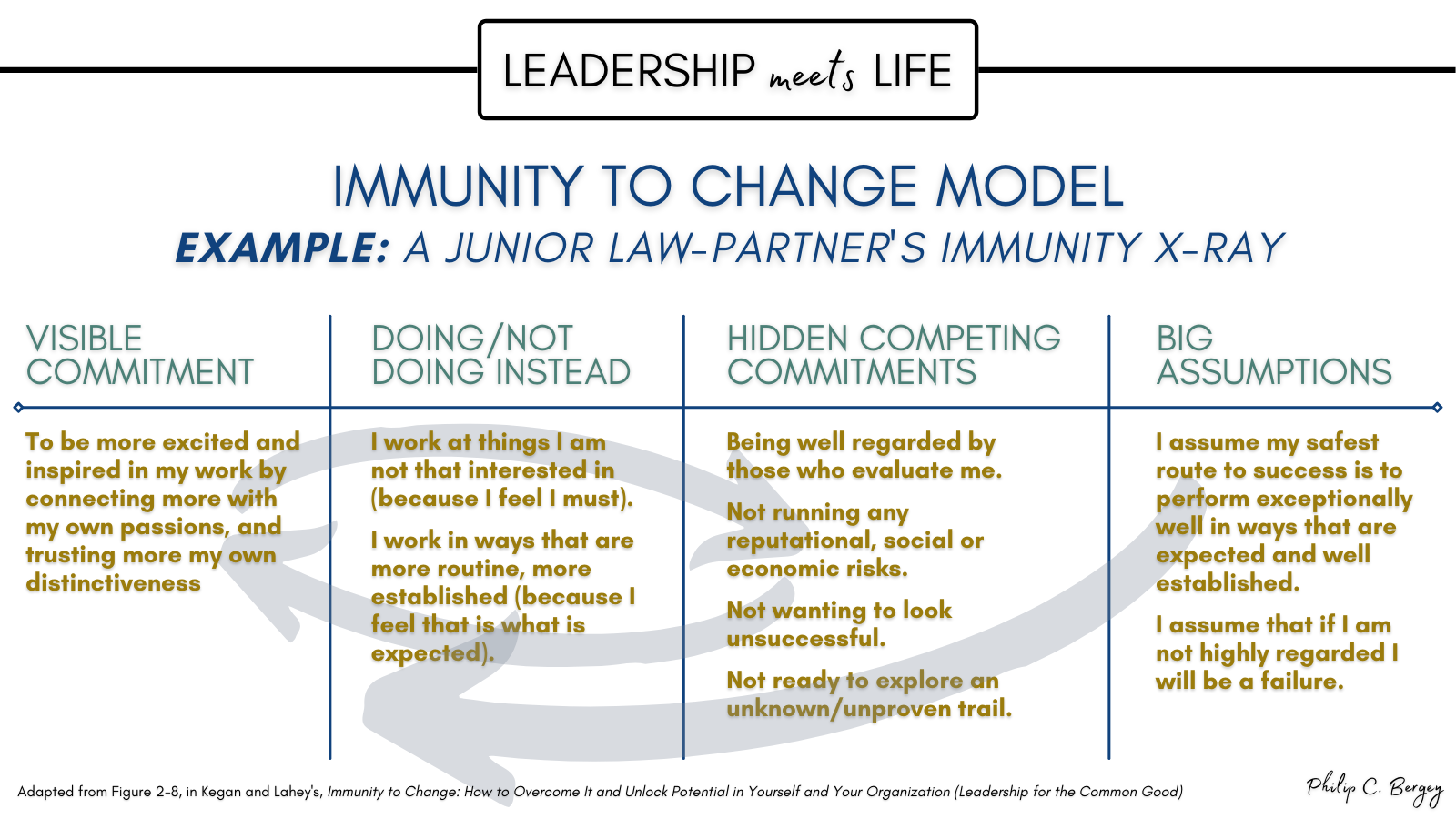
.png?width=100&name=Phil%20Bergey%20Headshot%20(1).png)




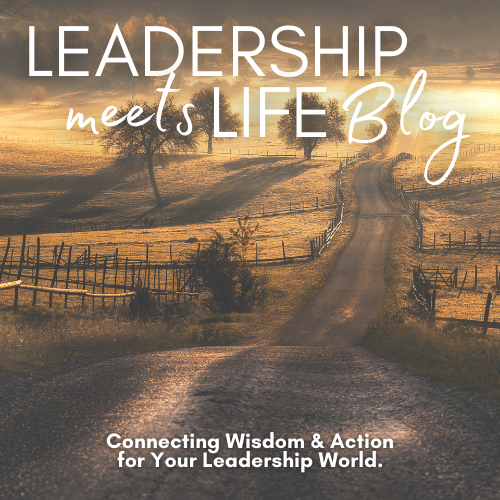
Comments